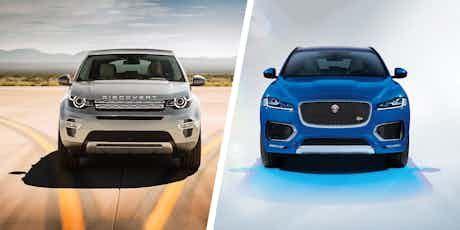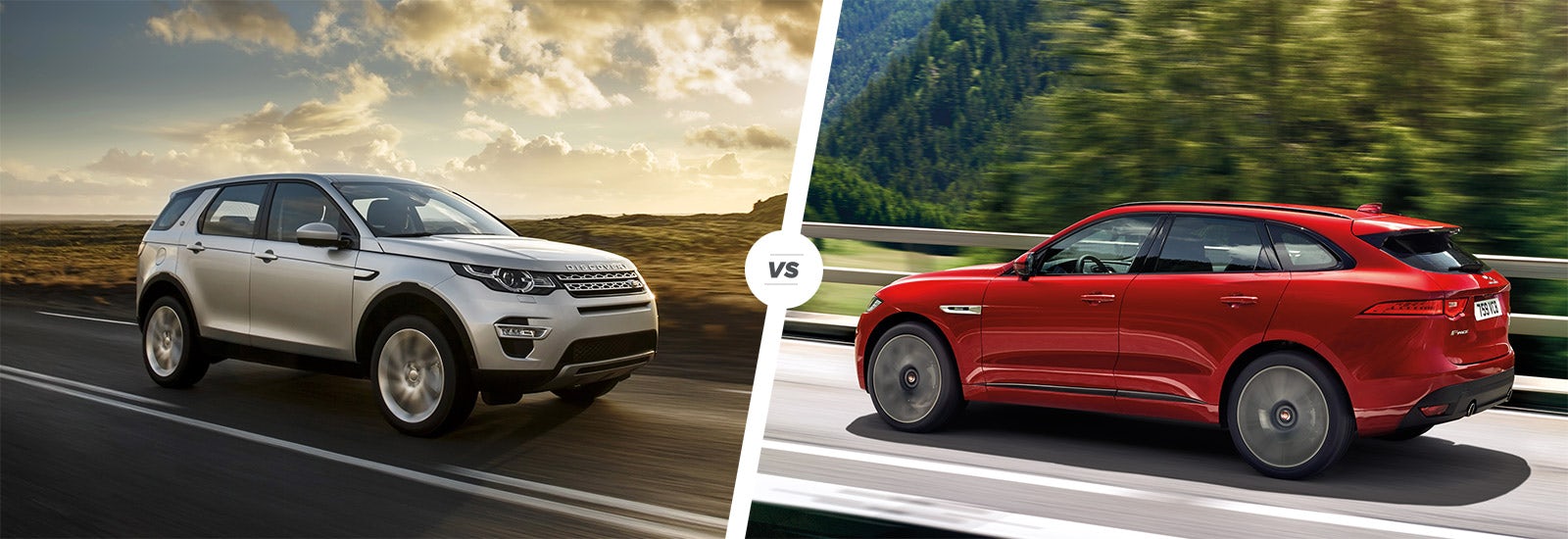Land Rover Discovery Sport vs Jaguar F-Pace
February 09, 2016 by carwow staff

If you’re looking for an upmarket British SUV with lots of style, chances are you might be considering the Land Rover Discovery Sport or the new Jaguar F-Pace. We’re taking a closer look at both to help decide which is best for you.
The Discovery Sport was created as the replacement for the old Freelander and offers brutish good looks, decent off-road ability and the option of seven seats. The F-Pace offers a dose of sportiness and more curvy styling in lieu of some off-road capabilities.

Land Rover Discovery Sport vs Jaguar F-Pace styling
Like much of the Land Rover range, the Discovery Sport has upright, squared styling. A metallic mesh grille is flanked by a pair of eye-like projector headlights giving the car an Evoque-like front end. While there are no sharp edges like those on the Defender, the Discovery Sport’s body has a bluff quality to it that echoes Land Rovers of old.
The F-Pace might be Jaguar’s first crossover SUV but the firm has managed to create a vehicle that looks both sporty and luxurious. The front the car has the familiar rounded rectangle grille and slim headlight design accompanied by a bulging bonnet found on other Jaguars. Beneath the grille is a set of oversized air intakes that hint that the F-Pace has a sporty pedigree.

Land Rover Discovery Sport vs Jaguar F-Pace interior
Inside the Discovery Sport, the interior is geared more towards function rather than style. As you’d expect from a spacious SUV, there’s more than enough room for all occupants and it can seat up to seven people.
With all the seats in place, the boot is almost non-existent. However, with the rear row folded away, a choice can be made between a huge boot or generous rear legroom – or a combination of the two. You get a maximum of 981 litres of space with five seats up and, with the second row folded, the capacity grows to 1,698 litres.
While the Discovery Sport’s standard equipment is decent, it has more of a minimalistic look and feel and seems slightly outdated when compared with the F-Pace. You get partial leather heated seats and a touch-screen infotainment system as standard bringing a little tech to the cabin.
The F-Pace’s interior looks more modern and has the luxury feel you’d expect to find in a Jaguar. There’s ample space inside the cabin and the car can seat up to five people, compared to the Discovery’s seven. Being a smaller SUV, luggage space isn’t as good as the Discovery Sport – offering just 650 litres of boot space, though it does have neat 40:20:40 split-folding rear seats weighing in its favour, in terms of practicality.
A large 10.2-inch touchscreen infotainment system dominates the centre console that’s a part of a tall dashboard. The controls have been laid out in a simple and user friendly manner and there are several trim levels available for the F-Pace, each one adds a lot of equipment, but also costs considerably more than the one before it.

Land Rover Discovery Sport vs Jaguar F-Pace driving
When it comes to driving, the Discovery Sport really comes into its own. The ride is well controlled yet very comfortable and its steering is responsive to inputs. Optional four-wheel drive means it performs well both on and off road and grips brilliantly when pushed.
A lot of work went into making the F-Pace a driver’s SUV and, thanks to its clever traction control which serves power to each of the four wheels, it offers fantastic grip. The sporty SUV also chooses the best suspension and throttle response settings depending upon the driving conditions.
Thanks to the two companies sharing technology, the F-Pace is also equipped with Land Rover’s clever All Surface Progress Control, which lets drivers navigate treacherous inclines without using the accelerator or brake pedals and it also doubles as a hill descent controller.

Land Rover Discovery Sport vs Jaguar F-Pace engines
The Discovery Sport comes with the option of two versions of the same 2.0-litre diesel – an entry-level 150hp unit or a more powerful 180hp one. This engine is especially good when paired with the new nine-speed automatic gearbox.
In comparison, the F-Pace comes with a number of diesel and petrol engine options, with the diesel options expected to be the most popular choice. The entry-level diesel is the same 180hp 2.0-litre unit from the Discovery Sport mated to a six-speed manual gearbox.
The cheapest F-Pace is rear-wheel drive only and will deliver 57.7mpg on the combined cycle. A more performance orientated 3.0-litre V6 diesel unit is also available that produces 300hp and sprints from 0-62mph in a respectable 6.2 seconds.
The only petrol engine available is the same supercharged V6 that can be found in the F-Type sports car. It makes 375hp and hits 0-62mph in 5.5 seconds.

Land Rover Discovery Sport vs Jaguar F-Pace value for money
The Discovery Sport costs just over £32,000, though a fully loaded car with all the optional extras can set you back more than £48,000. For this price, you get a very capable 4×4 that scores highly in terms of space and practicality, standing up well against other competitors in terms of value for money.
The F-Pace costs slightly more at £34,000 and, if you tick all the options, this jumps considerably to £65,000. With all the options selected, the F-Pace is a more luxurious SUV but, in terms of space and practicality, it doesn’t compare to the Discovery Sport. Buyers looking for style, however, need look no further.

Land Rover Discovery Sport vs Jaguar F-Pace verdict
The Discovery Sport is geared towards being a more practical 4×4 that offers a great drive both on and off-road. The Disco is cheaper overall and it offers much more in terms of space and practicality.
Despite the Sport in Discovery’s name, the F-Pace is geared more towards performance and packs more of a punch under the bonnet. It’s also arguably a better looking car and has a nicer interior, though you pay more for this level of luxury.
In short, if you’re buying with your head pick the Land Rover Discovery Sport but, if buying with your heart, the Jaguar F-Pace is the car for you.















